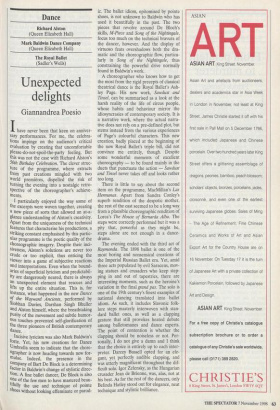Dance
Richard Alston (Queen Elizabeth Hall)
Unexpected delights
Giannandrea Poesio
Ihave never been that keen on anniver- sary performances. For me, the celebra- tions impinge on the audience's critical evaluation by creating that uncomfortable Please-do-not-spoil-the-party feeling. But this was not the case with Richard Alston's 50th Birthday Celebration. The clever struc- ture of the programme, where extracts from past creations mingled with two world premieres, dispelled the risk of turning the evening into a nostalgic retro- spective of the choreographer's achieve- ments.
I particularly enjoyed the way some of the excerpts were woven together, creating a new piece of sorts that allowed an at-a- glance understanding of Alston's creativity. Apart from the uniqueness of the technical features that characterise his productions, a striking constant emphasised by this partic- ular programme is the poetic quality of the Choreographic imagery. Despite their inci- siveness, Alston's solutions are never too crude or too explicit, thus enticing the viewer into a game of subjective reactions and interpretations. Even when the bound- aries of superficial lyricism and predictabil- ity are dangerously neared, there is always an unexpected element that rescues and lifts up the entire situation. This is, for instance, what happened in the new Dance Of the Wayward Ancients, performed by Siobhan Davies, Darshan Singh Bhuller and Alston himself, where the breathtaking Purity of the movement and subtle humor- ous touches prevented self-glorification of the three pioneers of British contemporary dance.
Incisive lyricism was also Mark Baldwin's forte. Yet, his new creations for Dance Umbrella seem to indicate that the chore- ographer is now heading towards new for- mulae. Indeed, the presence in the company of Bart De Block is a determining factor in Baldwin's change of stylistic direc- tion. A fine ballet dancer, De Block is also 0.11e of the few men to have mastered beau- tifully the use and technique of pointe Shoes without looking effeminate or parod-
ic. The ballet idiom, epitomised by pointe shoes, is not unknown to Baldwin who has used it beautifully in the past. The two pieces that revolve around De Bloch's skills, M-Piece and Song of the Nightingale, focus too much on the technical bravura of the dancer, however. And the display of virtuoso feats overshadows both the dra- matic and the choreographic flow, particu- larly in Song of the Nightingale, thus constraining the powerful drive normally found in Baldwin's work.
A choreographer who knows how to get the most from the rigid precepts of classical theatrical dance is the Royal Ballet's Ash- ley Page. His new work, Sawdust and Tinsel, can be summarised as a look at the harsh reality of the life of circus people, whose habits and behaviour mirror the idiosyncrasies of contemporary society. It is a narrative work, where the actual narra- tive does not rely on a pre-defined plot, but stems instead from the various experiences of Page's colourful characters. This new creation, badly placed at the beginning of the new Royal Ballet's triple bill, did not convince me entirely, though. Despite some wonderful moments of excellent choreography — to be found mainly in the duets that punctuate the action — Sawdust and Tinsel never takes off and looks rather too long.
There is little to say about the second item on the programme, MacMillan's Las Herrnanas. Apart from Sandra Conley's superb rendition of the despotic mother, the rest of the cast seemed to be a long way from a plausible choreographic rendition of Lorca's The House of Bernarda Alba. The steps were correctly performed but it was a pity that, powerful as they might be, steps alone are not enough in a dance- drama.
The evening ended with the third act of Raymonda. The 1898 ballet is one of the most boring and nonsensical creations of the Imperial Russian Ballet era. Yet, amid three acts populated by evil Saracens, mov- ing statues and crusaders who keep step- ping in and out of tapestries, there are interesting moments, such as the heroine's variation in the final grand pas. The solo is one of the 19th century's finest examples of national dancing translated into ballet idiom. As such, it includes Slavonic folk- lore steps masterly interwoven with stan- dard ballet ones, as well as a clapping gesture that still provokes heated debate among balletomanes and dance experts. The point of contention is whether the clapping should be noiseless or not. Per- sonally, I do not give a damn and I think that the choice is entirely up to each inter- preter. Darcey Busse11 opted for an ele- gant, yet perfectly audible clapping, and was utterly magnificent throughout the dif- ficult solo. Igor Zelensky, as the Hungarian crusader Jean de Brienne, was, alas, not at his best. As for the rest of the dancers, only Belinda Hatley stood out for elegance, neat technique and stylistic brilliance.


















































































 Previous page
Previous page